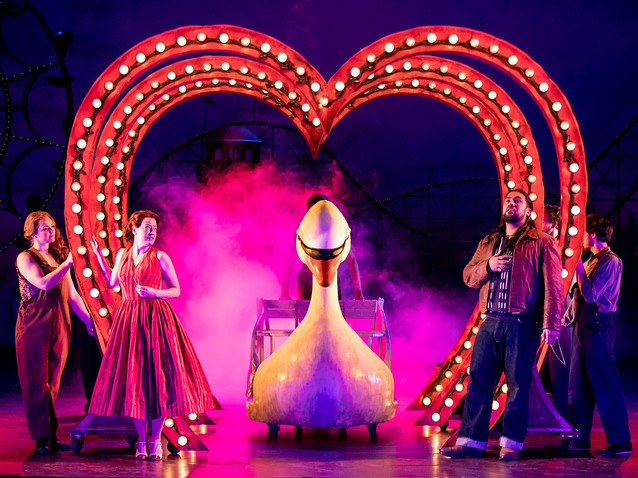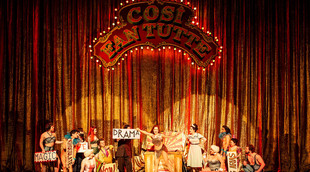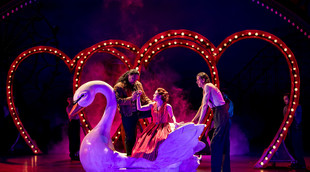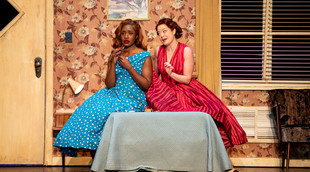 © Lloyd Winters
© Lloyd Winters
Così fan tutte of 1790 is the third and final opera (after Le nozze di Figaro and Don Giovanni) on which Mozart collaborated with the librettist Lorenzo Da Ponte. Originally set in Naples, it sees the philosopher Don Alfonso challenge two soldiers, Ferrando and Guglielmo, to prove that their respective fiancées, the sisters Dorabella and Fiordiligi, are faithful. He is certain that no woman ever is, but the younger men are so convinced of their own lovers’ fidelity that they agree to a wager with him. They will pretend to be called away to war and then return disguised as Albanians to try to win over the women, and they consent to doing exactly as Don Alfonso instructs for the period of the bet.
Part of the tension lies in the fact that, on the surface, Ferrando and Guglielmo do not wish to succeed in chatting up the sisters because this would prove what they wish to be the case, and win them the bet. However, especially since as strangers they are attempting to woo each others’ lovers, their desire to think they have the ability to win over any woman takes hold, which means that they start to try increasingly harder. Both women do capitulate, but just when the men are despairing and thinking there is no way they could marry them now, Don Alfonso proclaims that that is how all women are and that this should be accepted and celebrated. As a result, the opera usually has a happy ending, although it is a directorial choice whether to restore the lovers to their original couples or keep them with their newly formed ones. In addition, many productions opt for less cheerful conclusions so that, for example, all of the characters exit in different directions, suggesting that there was never real love between any of them in the first place.
Many directors today choose to set operas in the 1950s or ’60s, and the reasons why are not hard to find. The period is still recent enough to retain a certain air of familiarity, which can help make the action relatable. At the same time, it is still ‘historical’ enough to maintain many of the traditional values and hierarchies on which the works originally played. This is not, however, the only reason why Phelim McDermott’s production, a joint venture between English National Opera and The Metropolitan Opera that first appeared at the London Coliseum in 2014, sets the drama on Coney Island in the 1950s. To McDermott, amusement parks take us into a different realm with their magic, exuberance and allure, and it is this type of territory that the quartet of lovers enter as they all go on their extraordinary adventure.
To this end a skills ensemble is introduced comprising, among other things, strongmen, fire eaters and sword swallowers. In this way, Don Alfonso becomes almost a ringmaster who assumes the dual roles of conjuror and compere. He is the former in that he, in a sense, ‘conjures up’ the whole scenario, and the latter in that he has to keep the show moving in the right direction. A real compere cannot control what happens in an act once it has started, but at its end must frame whatever has befallen and adjust accordingly to ensure that everything proceeds smoothly. Here, as many scenes end, a golden curtain drops to reveal Don Alfonso, surrounded by his ‘entourage’ of circus performers, reflecting on the situation and introducing his next steps as he might the next routine.
The concept lends itself to moments of great dynamism such as during the Overture when Alfonso and the maid Despina call up the circus performers to tell us with signs that the opera is about to start and to be prepared for love, lust, lies, intrigue, poison, big arias and chocolate! The difficulty, however, is that Così is predominantly about six people, and much of the piece is played out in arias and intimate moments that do not lend themselves to dynamic visuals. This production recognises this and does not strive to incorporate the performers into every scene, but this is where it falls between two stools. Sometimes so much goes on in scenes that it proves distracting, but because such dynamism is not sustained from start to finish, the circus elements there are can feel like an add-on rather than essential to the evening.
We do see some fire eating and sword swallowing, but considering the skills these performers possess it seems a shame to reduce their role in Act I’s Finale to little more than falling over like dominoes when they could do so much more. Prior to this they gaze on the soldiers as they are ‘poisoned’, but because there are so many people around, it seems odd that the sisters should wait for Despina to appear to ask her specifically for help. Not everything has to be taken literally, but this does reveal how the approach takes the focus away from the people it should really be on. Similarly, when Guglielmo gazes distraught on Ferrando and Fiordiligi’s liaison, the fact that a dozen or so circus performers are also observing it dilutes the impact of his personal response to the ‘crisis’. Nevertheless, having the circus performers stare at the characters in scenes when they are at their most vulnerable is about as dark as this production gets. The opera can have extremely cruel undertones, and, though it can be presented in many ways, one cannot help feeling the chosen approach should have played these up more because behind all the glitz and glamour, circuses can surely be sad and dangerous places themselves.
There is still a lot that is entertaining about the production as Tom Pye’s sets see the lovers ride on teacups and swans, and Fiordiligi undergo three rotations of a ferris wheel as she sings ‘Per pietà, ben mio perdona’. The sisters occupy adjacent chalets in a Coney Island motel that do prove successful in introducing an ‘in one door, out the other’ element as Don Alfonso puts a glass to an (in reality) absent wall to hear what is happening in the next room. The way in which these sets can turn is similarly exploited so that when the sisters burst out of their chalets Don Alfonso can ‘innocently’ ask what the commotion is, even though he was the one causing it by trying to push the men into them. The attention to detail throughout is also staggering so that when Despina, who here becomes a chalet maid, describes how when one lover has gone you simply replace him with another, she illustrates the point by brandishing toilet rolls that reveal just how cheap and disposable she views men as.
The opera’s thesis ‘Così fan tutte’ is generally translated as ‘women are like that’, but in Jeremy Sams’s excellent translation it becomes ‘that’s human nature’, ensuring that the point is not made gender specific. At the same time an ‘i’ is placed over the ‘e’ on the words ‘Così fan tutte’ that appear on the curtain, thus converting the feminine to the masculine (Jan Philipp Gloger does something similar in his production for the Royal Opera House). While, however, this could be seen as a modern day director wanting to place a less misogynistic slant on the work, it could equally represent a point that has always been inherent in the opera. Mozart and Da Ponte may ostensibly have been telling us that ‘women are like that’, but surely they were inviting us to infer that ‘men are like that’ as well as in the opera they clearly do not behave any better than the women.
The real strength of the evening lies in its musical credentials and casting. Kerem Hasan’s conducting is thoughtful and pleasing, while the voices of Nardus Williams as Fiordiligi and Hanna Hipp as Dorabella work very well together. Williams’s sound is relatively direct, but it is imbued with the right degree of lightness, much sensitivity and very pleasing grains. Hipp’s is richer and more sumptuous and she delivers a first rate vocal performance. However, she makes Dorabella too strait-laced for the sister who is more on the verge of capitulating from the start. Her interpretation may have been deliberate so as not to reduce a complex character to an archetypal flirt, but it remains important that there is a real difference between the two sisters, and in terms of character this Dorabella could almost be Fiordiligi.
Amitai Pati has a beautifully light tenor and injects the right degree of vulnerability into Ferrando, generally the more sensitive soldier of the two, while Benson Wilson asserts his tremendous baritone to excellent effect as he gives a convincing portrayal of a Guglielmo who thinks rather too much of himself. Soraya Mafi is a Despina with everything as she combines an excellent soprano with superb comic timing, a certain knowingness and an ability to carry off a wide range of costumes. Finally, Neal Davies, with his strong bass-baritone, is a Don Alfonso who from the start comes across as shifty enough to make us think it would be a bad idea to trust him, yet also distinguished enough to make it believable that people actually would.
By Sam Smith
Così fan tutte | 14 - 22 March 2022 | London Coliseum
Photos credits © Lloyd Winters
the 20 of March, 2022 | Print



Comments